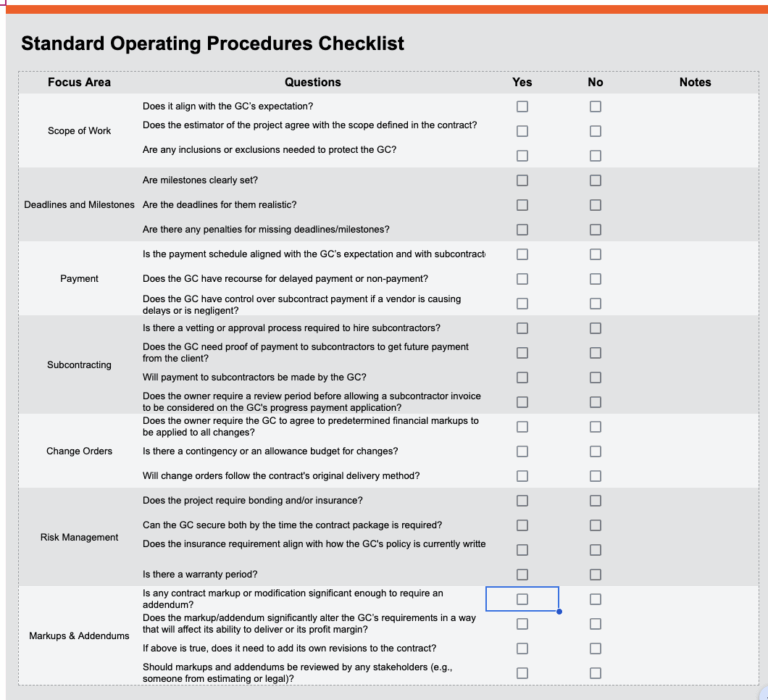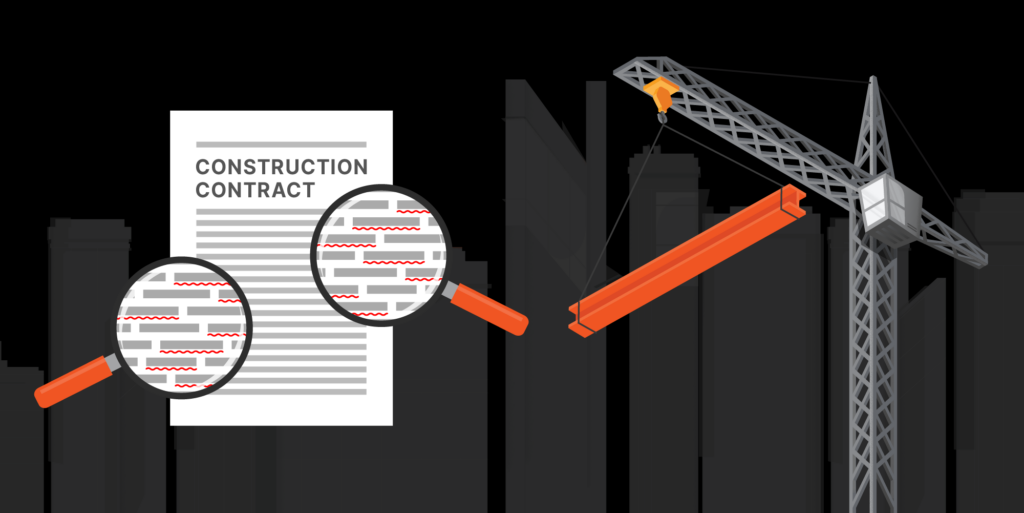— 7 min read
Using Standard Operating Procedures for Better Contract Management


Last Updated Aug 21, 2025

Kelsie Keleher
Senior Strategic Product Consultant, General Contractors
13 articles
Kelsie is a Senior Strategic Product Consultant for general contractors at Procore; working closely with civil and infrastructure clients. Kelsie holds a Masters of Business Administration (MBA) and has close to a decade of experience in construction accounting and finance.

Kacie Goff
Contributing Writer
90 articles
Kacie Goff is a construction writer who grew up in a construction family — her dad owned a concrete company. Over the last decade, she’s blended that experience with her writing expertise to create content for the Construction Progress Coalition, Newsweek, CNET, and others. She founded and runs her own agency, Jot Content, from her home in Ventura, California.
Last Updated Aug 21, 2025

Every construction project is different, meaning that GCs have to be continually agile and strategic about applying their experience. Major categories change from project to project, from the owner to the delivery method.
Fortunately, that doesn’t mean the GC goes into the project blind: They have the contract to guide them. The contract documents should clearly outline the owner’s requirements on that particular project. An accurate contract puts everyone — the GC, the client and other stakeholders — in a good place to succeed on their shared goals.
Even though the contract should eliminate a lot of uncertainty, variety comes back into play here, too. Different projects apply different contract types. With so many variables in play, GCs need standard operating procedures, or SOPs, to manage them. This directly minimizes the risks and challenges that arise with weak contract management.
Table of contents
The Problems With Weak Contract Management
To make it clear why GCs benefit from investing some effort in contract management SOPs, it helps to clarify what these standardized processes guard against. For that, teams can look at both the upstream and downstream exposures created by weak contract management.
Upstream Risks From Poor Contract Development
If the contract isn’t developed in a way that clearly communicates the project requirements, it opens the GC up to potential problems in a number of areas. Reports show errors and omissions in contract documents are the second-highest cause of disputes.
To get more granular, an unclear contract could lead to the GC facing challenges around:
- Meeting unclear payroll requirements (e.g., tracking, reporting)
- Missing addendums
- Missed deadlines due to change management
- Insufficient insurance coverage
- Scope creep/gaps
To help here, the GC needs a clear definition of the different clients with which it may work. Then, they should plan for the different delivery methods and other requirements (e.g., insurance, payroll reporting) that comes with each of those client categories.
Downstream Challenges From Poor Contract Language
As the project moves forward, vague terms or broad language in the contract can affect outcomes.
If a GC has a longstanding relationship with a specialty contractor, for example, they might assume that a handshake agreement on the jobsite will be sufficient for expanded scope or additional work.
Operating on trust rather than a formalized agreement opens the firm up to a range of risks, though. Unclear responsibilities or an inadequate scope can lead to disputes — potentially costly ones.
Similarly, poor contract management can lead to chaotic change order processes, delayed payments, missed project documentation and a range of other problems. All told, managing a project gets significantly more difficult when the GC doesn’t have clear expectations and defined processes for contract delivery.
Using SOP Checklists To Support Contract Management
GCs benefit from having an SOP for contract review before signing. This helps them uncover contract language and requirements that fall outside of commonly used terms and identify risks that may require further review before execution. Some examples could include legal review, bonding and insurance requirements or even additional licensing.
An effective and efficient way for GC's to review terms is a clear and comprehensive checklist of important items, steps for internal review and tasks for completion that are critical to successful execution and handoff to operations teams.
A checklist provides the contract administrator with a framework of requirements. It’s clear from the moment that a file reaches their desk which documents and procedures must be followed to ensure the project is ready to begin. These checklists can be tailored by category, such as client, contract type, funding source, line of business/department, etc.

Kelsie Keleher
Senior Strategic Product Consultant, General Contractors
Procore
Developing standard operating procedures might sound complicated, and teams might be daunted by having a set of complicated rules to follow. Generally, though, SOPs work best when they’re simple.
For that, GCs can turn to checklist-based SOPs. Specifically, they might want to develop checklists to trigger actions around scope of work, milestones, payment, subcontracting, risk management and more. A templated checklist can come in handy here.
Free Download
Standard Operating Procedures Checklist
This simple checklist has common categories and questions general contractors can use to develop their SOPs.
- Free, ready-to-use starter template
- Customizable for any and every project
- Trusted by construction professionals


Having a checklist with questions like these helps GCs catch issues early. If the contract lays out net 30 payment terms, for example, but a sub requires net 10, the GC needs to either make a plan to bridge that gap or find a different contractor.
Or if the insurance requirements vary from the GC’s standard coverage package, it can trigger a team member to call their insurer to get additional coverage in place.
All of the above is only skimming the surface, though. The GC should look back on past projects to determine what needs to be on its contract management SOP checklists. Areas in which it faced disputes, delays or other challenges often highlight opportunities to add items to its checklist.
We have a template on how this information is stored. And it makes you explicitly aware when you're missing something because that box hasn't been checked, the file's empty and you can start to go comb through your contracts and more efficiently understand what's missing.
Kelsie Keleher
Senior Strategic Product Consultant, General Contractors
Procore
Best Practices for Establishing Contract Management SOPs
To create their own contract management SOPs — and make them as effective as possible — GCs can benefit from doing the following.
Looping in All of the Appropriate Stakeholders
As they initially develop SOPs, GCs should solicit feedback from all team members.
Each department interacts with the contract in its own way. As a result, the recommendations from the accounting team will probably be very different from the project manager or executive, for example. Capturing all of the feedback and distilling it into SOPs helps GCs develop stronger, more robust contract management processes.
Then, the firm’s leadership should make sure all internal stakeholders are appropriately trained on the SOPs. Training and shadowing might be beneficial here.
Developing an Organizing System for Supporting Documentation
As the GC develops its contract management SOPs, it should also create a repository for checklist items that will result in a tangible asset (e.g., the GC’s bond, proof of insurance from a subcontractor). That should offer role-based access to those assets to make sure team members have access to the latest version.
With an established, organized filing system, the supporting documentation doesn’t get lost as the project moves forward. This makes it easy for all team members to find what they need when they need it. Once a system is in place, other procedures like annual audits and prequalification become much more efficient because the documentation is exactly where it should be.
The benefit of [the SOP] is that you're consistent. You’re doing the same thing over and over again. People can find what they're looking for when they need to find contract documentation and easily identify outstanding tasks that may pose a risk to a project start date.
Kelsie Keleher
Senior Strategic Product Consultant, General Contractors
Procore
Establishing and Following Controls
As a best practice, GCs should never let individual team members execute a package without dual approval. Another person should always review the package first. In fact, they might add a review line item as the final step in their SOP. If legal or an estimator needs to be involved, that review step should absolutely be captured in the standard operating procedure.
The SOPs can build in further controls, too. As an example, the GC might add a step or checklist item that has the team member confirm that contracts don’t have any signatures when going to a subcontractor. This way, if the sub marks up the contract and then signs it, the GC isn’t legally bound to their markup.
Continually Refining the SOPs
Standard operating procedures are never finalized. Even when they’re set, the GC should consider them final draft status. That’s because those SOPs will need to evolve as projects, clients and even technologies change.
Regular check-ins help the GC continuously improve its contract management SOPs. Adding 15 minutes during a monthly meeting might be sufficient to solicit feedback that can then be implemented.
With standard operating procedures to shape its contract management processes, a GC firm avoids risk and sets itself up to more successfully run projects. That protects its profit margins and its relationships with clients and partners — and saves its team members from the unpleasant work of sorting out contract snags.
Was this article helpful?
Thank you for your submission.
0%
0%
You voted that this article was . Was this a mistake? If so, change your vote
Scroll less, learn more about construction.
Subscribe to The Blueprint, Procore’s construction newsletter, to get content from industry experts delivered straight to your inbox.
By clicking this button, you agree to our Privacy Notice and Terms of Service.
Thank you!
You’re signed up to receive The Blueprint newsletter from Procore. You can unsubscribe at any time.
Categories:
Written by

Kelsie Keleher
Senior Strategic Product Consultant, General Contractors | Procore
13 articles
Kelsie is a Senior Strategic Product Consultant for general contractors at Procore; working closely with civil and infrastructure clients. Kelsie holds a Masters of Business Administration (MBA) and has close to a decade of experience in construction accounting and finance.
View profile
Kacie Goff
Contributing Writer | Procore Technologies
90 articles
Kacie Goff is a construction writer who grew up in a construction family — her dad owned a concrete company. Over the last decade, she’s blended that experience with her writing expertise to create content for the Construction Progress Coalition, Newsweek, CNET, and others. She founded and runs her own agency, Jot Content, from her home in Ventura, California.
View profileExplore more helpful resources

Understanding Supplementary Conditions on Construction Contracts
No two construction projects are exactly alike — and the same goes for construction contracts. Even when using a standard contract form, owners and contractors sometimes use supplementary conditions to...

A Straightforward Guide to Construction Contract Review
Construction contracts are like the glue for the project team. They’re the ties that bind the working relationships and goals for the project, containing information about responsibilities, liabilities and processes...

Escalation Clauses in Construction Contracts: When and How They Apply
In construction contracts, an escalation clause allows for the escalation of a certain price for labor or materials to be used in a construction project. This type of clause is most...

Scope Gap: Addressing Ambiguous Project Requirements
To turn contract documents into an actual building, every construction project requires stakeholders to complete certain items of work. Ideally, the scope of work outlines those items and clarifies who’s...
Free Tools
Calculators
Use our calculators to estimate the cost of construction materials for your next project.
Templates
Find a template to help you with your construction project tasks.
Material Price Tracker
Get the latest U.S. retail prices and view historical trends for common building materials.
Glossary
Explore key terms and phrases used in the industry.
